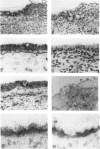Abstract
The mechanism of transmission of HIV from the male to the female genital tract or in the reverse order is not clear. CD4 glycoprotein is the receptor for HIV and Langerhans cells and the related dendritic cells could play a role in the initial transmission of HIV. Fc receptors (FcR) for IgG might be involved in antibody-mediated binding of HIV. We carried out an immunohistological study of normal human cervical and vaginal epithelia for the presence of CD4 glycoprotein, Langerhans cells and FcR to IgG. CD4+ glycoprotein was not found in the vaginal or cervical epithelium, with the exception of a few endocervical epithelial cells. A small number of CD4+ mononuclear cells were found in the endocervical epithelium of a third of the specimens but a large number of CD4+ cells was found in the submucosa of most of the cervical and vaginal specimens. Langerhans cells expressing CD4, HLA class II, Fc gamma R2 and Fc gamma R3 were detected in most vaginal, ectocervical and transformation zone epithelia and in 9/14 endocervical tissues. Fc gamma R3 was detected in about two-thirds of the columnar endocervical epithelium and the transformation zone. A smaller number of specimens expressed Fc gamma R2 in these epithelia, but Fc gamma R1 was not detected. We then demonstrated mRNA for Fc gamma R3 in the columnar endocervical epithelial cells and transformation zone by in situ hybridization, using a CD16-RNA probe. Fc gamma R3 and Fc gamma R2 gene transcripts were also found in fetal cervical tissue by applying the polymerase chain reaction to amplify portions of the Fc gamma R3 and Fc gamma R2 coding sequences in cDNA prepared from fetal RNA. HLA-DR was found in the endocervical cells, transformation zone and in Langerhans cells of all specimens. The presence of Langerhans cells, Fc gamma receptors and HLA class II antigen offers three potential mechanisms for cervico-vaginal HIV transmission: (i) direct HIV infection of Langerhans cells, (ii) binding of HIV antibody complexes to cervical epithelial Fc gamma receptors and (iii) binding of HIV infected CD4+ cells to cervical HLA class II antigen which may infect these or the adjacent CD4+ cells.
Full text
PDF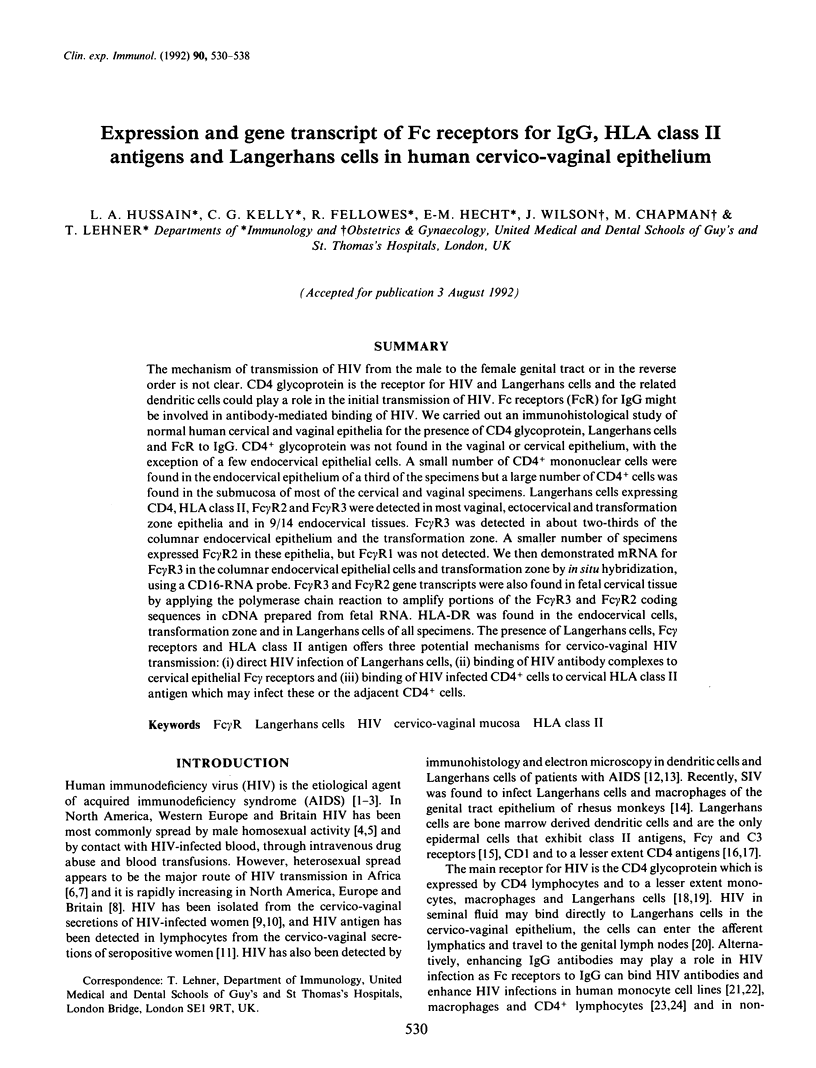
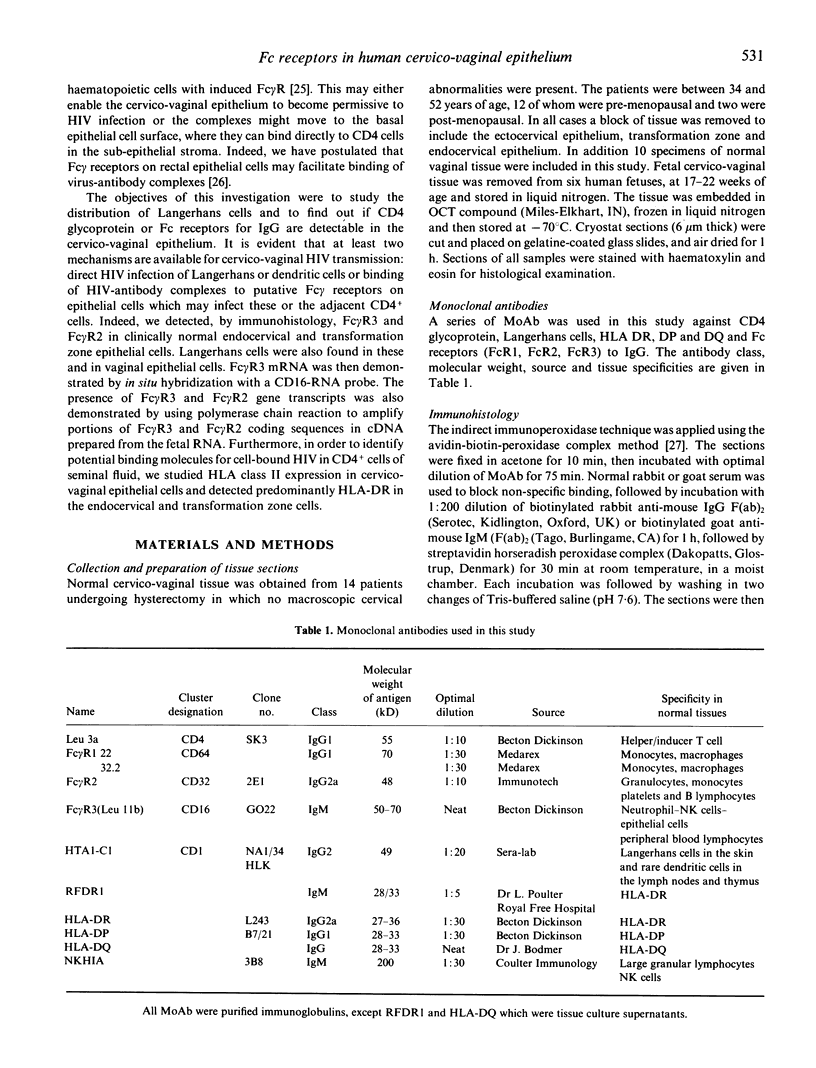
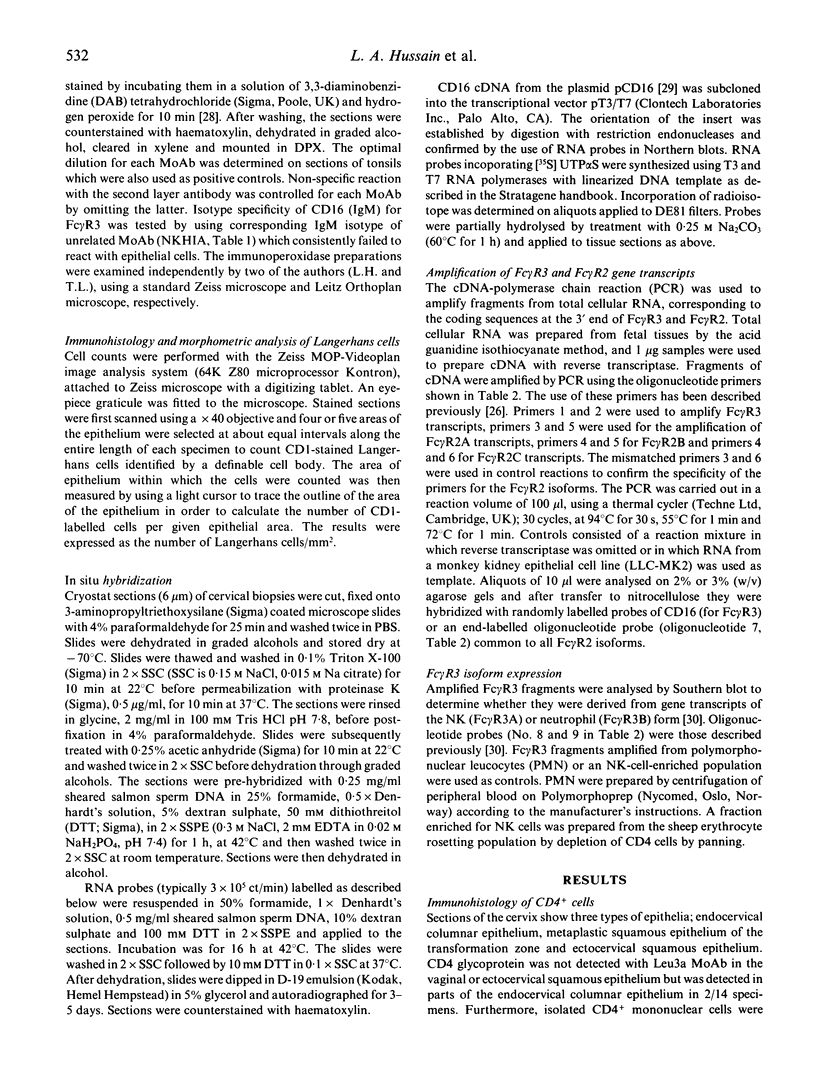
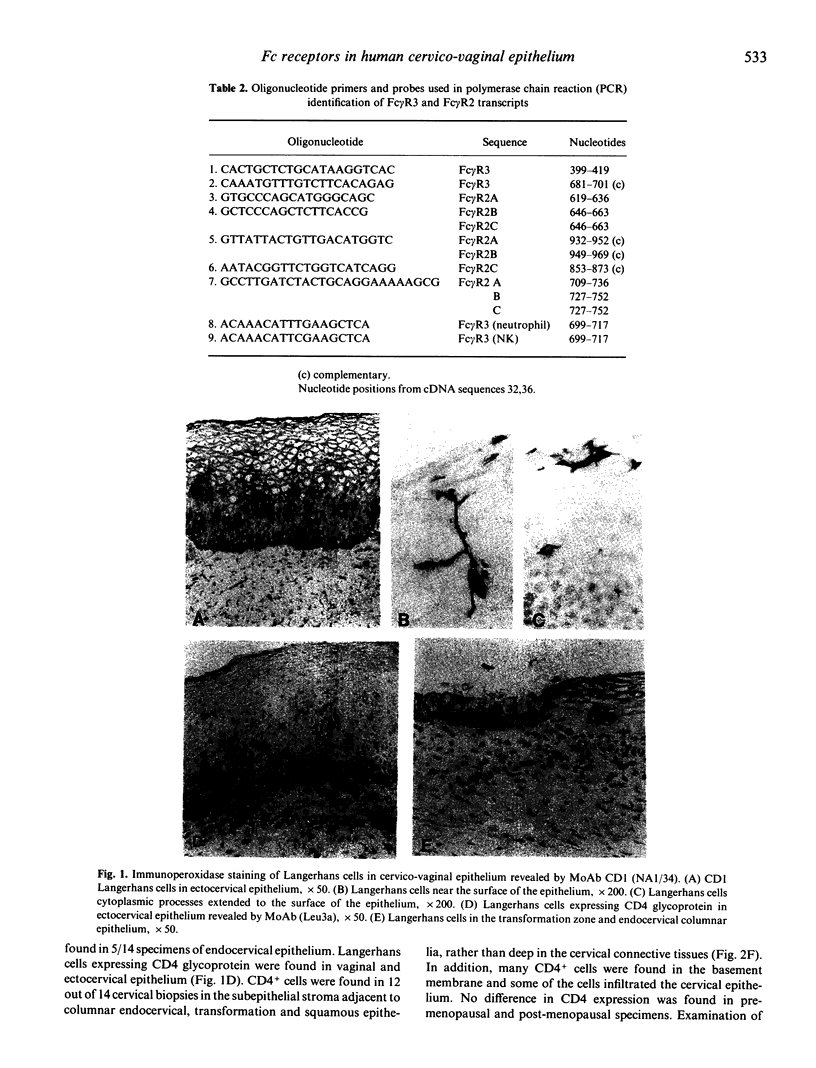
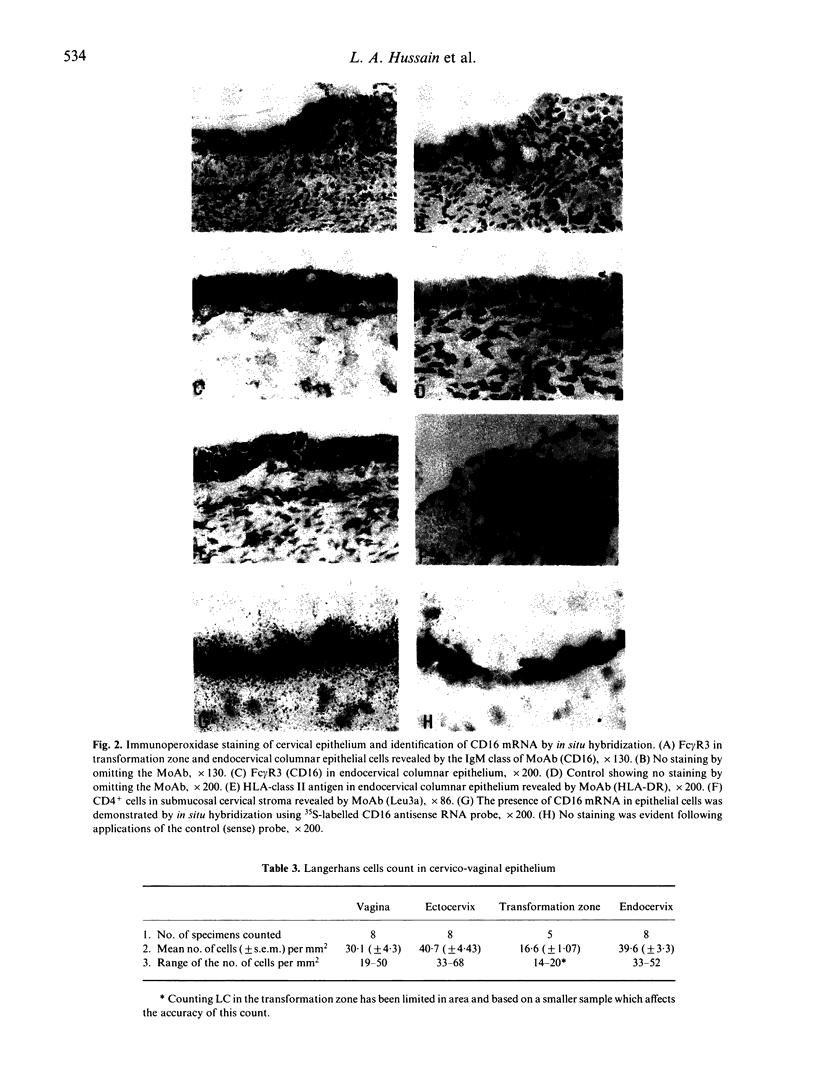
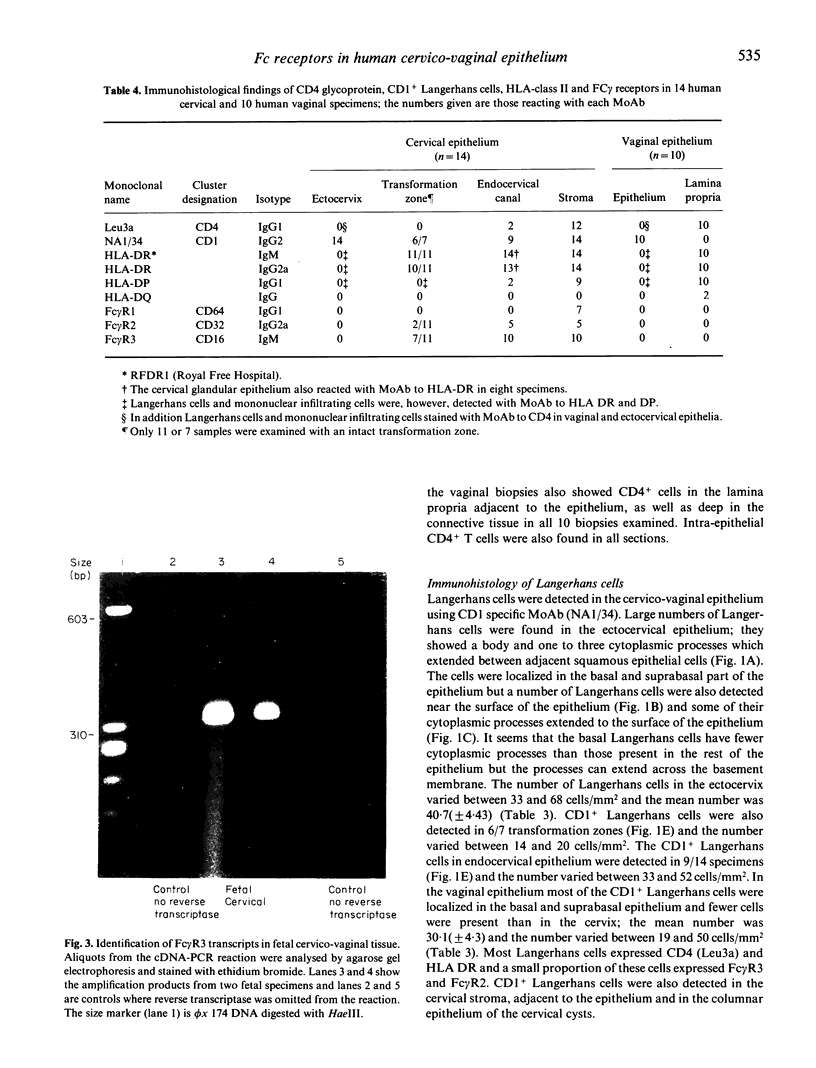
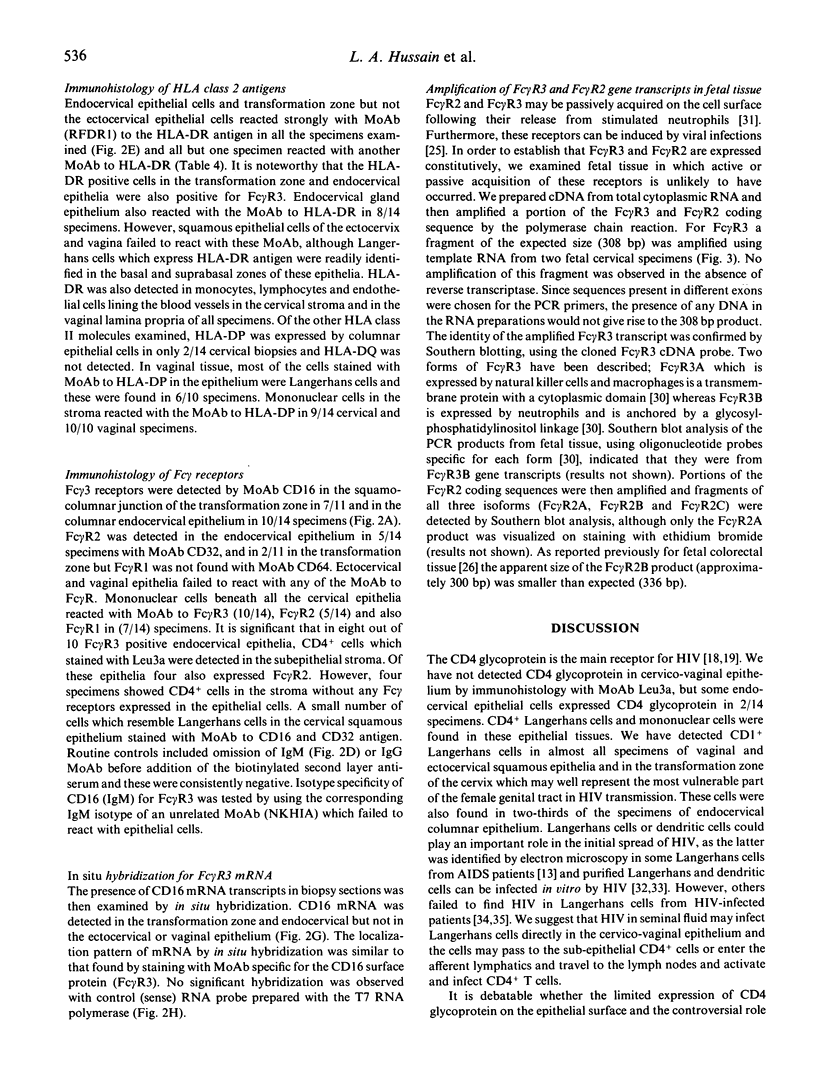
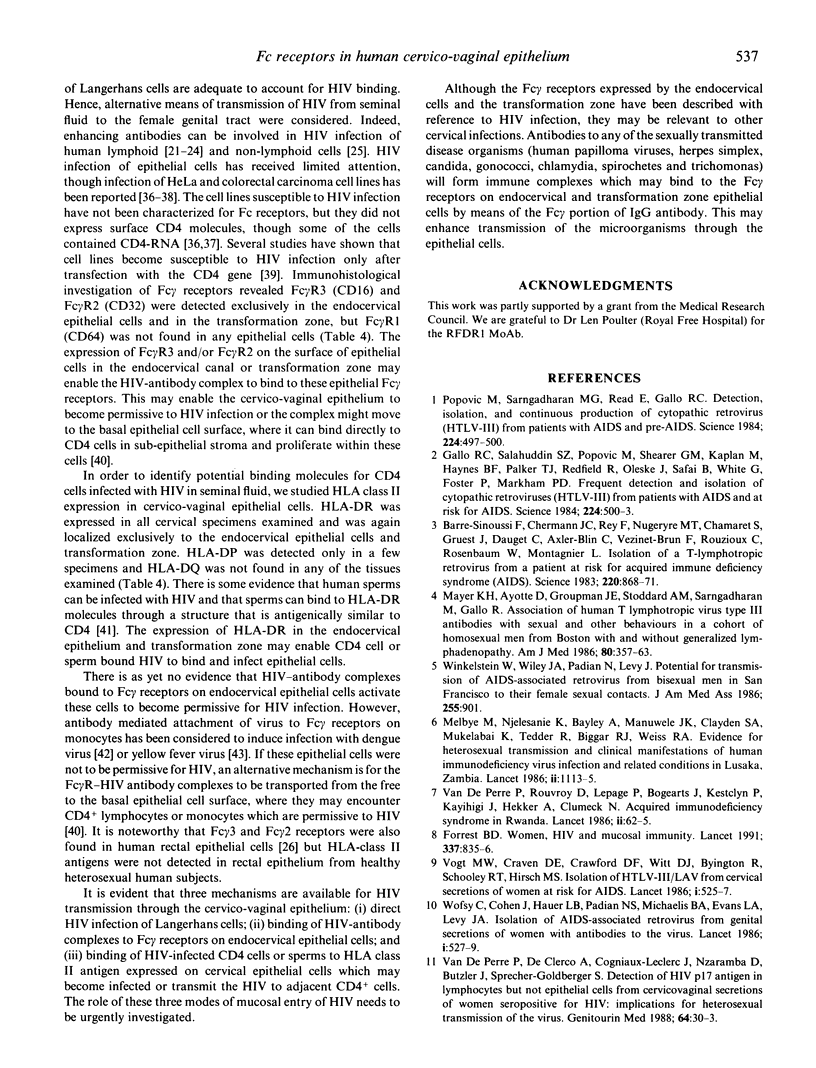
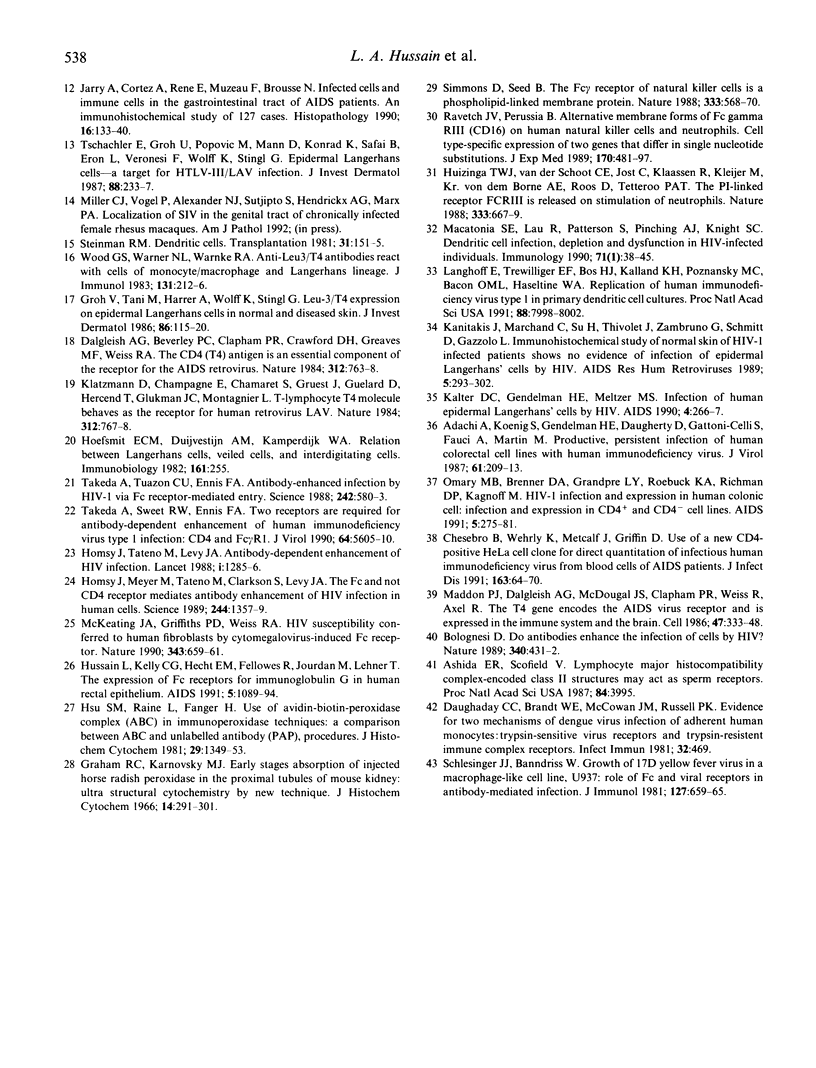
Images in this article
Selected References
These references are in PubMed. This may not be the complete list of references from this article.
- Adachi A., Koenig S., Gendelman H. E., Daugherty D., Gattoni-Celli S., Fauci A. S., Martin M. A. Productive, persistent infection of human colorectal cell lines with human immunodeficiency virus. J Virol. 1987 Jan;61(1):209–213. doi: 10.1128/jvi.61.1.209-213.1987. [DOI] [PMC free article] [PubMed] [Google Scholar]
- Antibody-dependent enhancement of HIV infection. Lancet. 1988 Jun 4;1(8597):1285–1286. [PubMed] [Google Scholar]
- Barré-Sinoussi F., Chermann J. C., Rey F., Nugeyre M. T., Chamaret S., Gruest J., Dauguet C., Axler-Blin C., Vézinet-Brun F., Rouzioux C. Isolation of a T-lymphotropic retrovirus from a patient at risk for acquired immune deficiency syndrome (AIDS). Science. 1983 May 20;220(4599):868–871. doi: 10.1126/science.6189183. [DOI] [PubMed] [Google Scholar]
- Bolognesi D. P. AIDS. Do antibodies enhance the infection of cells by HIV? Nature. 1989 Aug 10;340(6233):431–432. doi: 10.1038/340431a0. [DOI] [PMC free article] [PubMed] [Google Scholar]
- Chesebro B., Wehrly K., Metcalf J., Griffin D. E. Use of a new CD4-positive HeLa cell clone for direct quantitation of infectious human immunodeficiency virus from blood cells of AIDS patients. J Infect Dis. 1991 Jan;163(1):64–70. doi: 10.1093/infdis/163.1.64. [DOI] [PubMed] [Google Scholar]
- Dalgleish A. G., Beverley P. C., Clapham P. R., Crawford D. H., Greaves M. F., Weiss R. A. The CD4 (T4) antigen is an essential component of the receptor for the AIDS retrovirus. Nature. 1984 Dec 20;312(5996):763–767. doi: 10.1038/312763a0. [DOI] [PubMed] [Google Scholar]
- Daughaday C. C., Brandt W. E., McCown J. M., Russell P. K. Evidence for two mechanisms of dengue virus infection of adherent human monocytes: trypsin-sensitive virus receptors and trypsin-resistant immune complex receptors. Infect Immun. 1981 May;32(2):469–473. doi: 10.1128/iai.32.2.469-473.1981. [DOI] [PMC free article] [PubMed] [Google Scholar]
- Forrest B. D. Women, HIV, and mucosal immunity. Lancet. 1991 Apr 6;337(8745):835–836. doi: 10.1016/0140-6736(91)92527-9. [DOI] [PubMed] [Google Scholar]
- Gallo R. C., Salahuddin S. Z., Popovic M., Shearer G. M., Kaplan M., Haynes B. F., Palker T. J., Redfield R., Oleske J., Safai B. Frequent detection and isolation of cytopathic retroviruses (HTLV-III) from patients with AIDS and at risk for AIDS. Science. 1984 May 4;224(4648):500–503. doi: 10.1126/science.6200936. [DOI] [PubMed] [Google Scholar]
- Graham R. C., Jr, Karnovsky M. J. The early stages of absorption of injected horseradish peroxidase in the proximal tubules of mouse kidney: ultrastructural cytochemistry by a new technique. J Histochem Cytochem. 1966 Apr;14(4):291–302. doi: 10.1177/14.4.291. [DOI] [PubMed] [Google Scholar]
- Groh V., Tani M., Harrer A., Wolff K., Stingl G. Leu-3/T4 expression on epidermal Langerhans cells in normal and diseased skin. J Invest Dermatol. 1986 Feb;86(2):115–120. doi: 10.1111/1523-1747.ep12284090. [DOI] [PubMed] [Google Scholar]
- Hoefsmit E. C., Duijvestijn A. M., Kamperdijk E. W. Relation between langerhans cells, veiled cells, and interdigitating cells. Immunobiology. 1982 Apr;161(3-4):255–265. doi: 10.1016/S0171-2985(82)80081-8. [DOI] [PubMed] [Google Scholar]
- Homsy J., Meyer M., Tateno M., Clarkson S., Levy J. A. The Fc and not CD4 receptor mediates antibody enhancement of HIV infection in human cells. Science. 1989 Jun 16;244(4910):1357–1360. doi: 10.1126/science.2786647. [DOI] [PubMed] [Google Scholar]
- Hsu S. M., Raine L. Protein A, avidin, and biotin in immunohistochemistry. J Histochem Cytochem. 1981 Nov;29(11):1349–1353. doi: 10.1177/29.11.6172466. [DOI] [PubMed] [Google Scholar]
- Huizinga T. W., van der Schoot C. E., Jost C., Klaassen R., Kleijer M., von dem Borne A. E., Roos D., Tetteroo P. A. The PI-linked receptor FcRIII is released on stimulation of neutrophils. Nature. 1988 Jun 16;333(6174):667–669. doi: 10.1038/333667a0. [DOI] [PubMed] [Google Scholar]
- Hussain L. A., Kelly C. G., Hecht E. M., Fellowes R., Jourdan M., Lehner T. The expression of Fc receptors for immunoglobulin G in human rectal epithelium. AIDS. 1991 Sep;5(9):1089–1094. doi: 10.1097/00002030-199109000-00004. [DOI] [PubMed] [Google Scholar]
- Jarry A., Cortez A., René E., Muzeau F., Brousse N. Infected cells and immune cells in the gastrointestinal tract of AIDS patients. An immunohistochemical study of 127 cases. Histopathology. 1990 Feb;16(2):133–140. doi: 10.1111/j.1365-2559.1990.tb01081.x. [DOI] [PubMed] [Google Scholar]
- Kanitakis J., Marchand C., Su H., Thivolet J., Zambruno G., Schmitt D., Gazzolo L. Immunohistochemical study of normal skin of HIV-1-infected patients shows no evidence of infection of epidermal Langerhans cells by HIV. AIDS Res Hum Retroviruses. 1989 Jun;5(3):293–302. doi: 10.1089/aid.1989.5.293. [DOI] [PubMed] [Google Scholar]
- Kanitakis J., Thivolet J. Infection of human epidermal Langerhans' cells by HIV. AIDS. 1990 Mar;4(3):266–268. [PubMed] [Google Scholar]
- Klatzmann D., Champagne E., Chamaret S., Gruest J., Guetard D., Hercend T., Gluckman J. C., Montagnier L. T-lymphocyte T4 molecule behaves as the receptor for human retrovirus LAV. Nature. 1984 Dec 20;312(5996):767–768. doi: 10.1038/312767a0. [DOI] [PubMed] [Google Scholar]
- Langhoff E., Terwilliger E. F., Bos H. J., Kalland K. H., Poznansky M. C., Bacon O. M., Haseltine W. A. Replication of human immunodeficiency virus type 1 in primary dendritic cell cultures. Proc Natl Acad Sci U S A. 1991 Sep 15;88(18):7998–8002. doi: 10.1073/pnas.88.18.7998. [DOI] [PMC free article] [PubMed] [Google Scholar]
- Macatonia S. E., Lau R., Patterson S., Pinching A. J., Knight S. C. Dendritic cell infection, depletion and dysfunction in HIV-infected individuals. Immunology. 1990 Sep;71(1):38–45. [PMC free article] [PubMed] [Google Scholar]
- Maddon P. J., Dalgleish A. G., McDougal J. S., Clapham P. R., Weiss R. A., Axel R. The T4 gene encodes the AIDS virus receptor and is expressed in the immune system and the brain. Cell. 1986 Nov 7;47(3):333–348. doi: 10.1016/0092-8674(86)90590-8. [DOI] [PubMed] [Google Scholar]
- Mayer K. H., Ayotte D., Groopman J. E., Stoddard A. M., Sarngadharan M., Gallo R. Association of human T lymphotropic virus type III antibodies with sexual and other behaviors in a cohort of homosexual men from Boston with and without generalized lymphadenopathy. Am J Med. 1986 Mar;80(3):357–363. doi: 10.1016/0002-9343(86)90706-0. [DOI] [PubMed] [Google Scholar]
- McKeating J. A., Griffiths P. D., Weiss R. A. HIV susceptibility conferred to human fibroblasts by cytomegalovirus-induced Fc receptor. Nature. 1990 Feb 15;343(6259):659–661. doi: 10.1038/343659a0. [DOI] [PubMed] [Google Scholar]
- Melbye M., Njelesani E. K., Bayley A., Mukelabai K., Manuwele J. K., Bowa F. J., Clayden S. A., Levin A., Blattner W. A., Weiss R. A. Evidence for heterosexual transmission and clinical manifestations of human immunodeficiency virus infection and related conditions in Lusaka, Zambia. Lancet. 1986 Nov 15;2(8516):1113–1115. doi: 10.1016/s0140-6736(86)90527-1. [DOI] [PubMed] [Google Scholar]
- Omary M. B., Brenner D. A., de Grandpre L. Y., Roebuck K. A., Richman D. D., Kagnoff M. F. HIV-1 infection and expression in human colonic cells: infection and expression in CD4+ and CD4- cell lines. AIDS. 1991 Mar;5(3):275–281. doi: 10.1097/00002030-199103000-00005. [DOI] [PubMed] [Google Scholar]
- Popovic M., Sarngadharan M. G., Read E., Gallo R. C. Detection, isolation, and continuous production of cytopathic retroviruses (HTLV-III) from patients with AIDS and pre-AIDS. Science. 1984 May 4;224(4648):497–500. doi: 10.1126/science.6200935. [DOI] [PubMed] [Google Scholar]
- Ravetch J. V., Perussia B. Alternative membrane forms of Fc gamma RIII(CD16) on human natural killer cells and neutrophils. Cell type-specific expression of two genes that differ in single nucleotide substitutions. J Exp Med. 1989 Aug 1;170(2):481–497. doi: 10.1084/jem.170.2.481. [DOI] [PMC free article] [PubMed] [Google Scholar]
- Schlesinger J. J., Brandriss M. W. Growth of 17D yellow fever virus in a macrophage-like cell line, U937: role of Fc and viral receptors in antibody-mediated infection. J Immunol. 1981 Aug;127(2):659–665. [PubMed] [Google Scholar]
- Simmons D., Seed B. The Fc gamma receptor of natural killer cells is a phospholipid-linked membrane protein. Nature. 1988 Jun 9;333(6173):568–570. doi: 10.1038/333568a0. [DOI] [PubMed] [Google Scholar]
- Steinman R. M. Dendritic cells. Transplantation. 1981 Mar;31(3):151–155. [PubMed] [Google Scholar]
- Takeda A., Sweet R. W., Ennis F. A. Two receptors are required for antibody-dependent enhancement of human immunodeficiency virus type 1 infection: CD4 and Fc gamma R. J Virol. 1990 Nov;64(11):5605–5610. doi: 10.1128/jvi.64.11.5605-5610.1990. [DOI] [PMC free article] [PubMed] [Google Scholar]
- Takeda A., Tuazon C. U., Ennis F. A. Antibody-enhanced infection by HIV-1 via Fc receptor-mediated entry. Science. 1988 Oct 28;242(4878):580–583. doi: 10.1126/science.2972065. [DOI] [PubMed] [Google Scholar]
- Tschachler E., Groh V., Popovic M., Mann D. L., Konrad K., Safai B., Eron L., diMarzo Veronese F., Wolff K., Stingl G. Epidermal Langerhans cells--a target for HTLV-III/LAV infection. J Invest Dermatol. 1987 Feb;88(2):233–237. doi: 10.1111/1523-1747.ep12525402. [DOI] [PubMed] [Google Scholar]
- Van de Perre P., De Clercq A., Cogniaux-Leclerc J., Nzaramba D., Butzler J. P., Sprecher-Goldberger S. Detection of HIV p17 antigen in lymphocytes but not epithelial cells from cervicovaginal secretions of women seropositive for HIV: implications for heterosexual transmission of the virus. Genitourin Med. 1988 Feb;64(1):30–33. doi: 10.1136/sti.64.1.30. [DOI] [PMC free article] [PubMed] [Google Scholar]
- Vogt M. W., Witt D. J., Craven D. E., Byington R., Crawford D. F., Schooley R. T., Hirsch M. S. Isolation of HTLV-III/LAV from cervical secretions of women at risk for AIDS. Lancet. 1986 Mar 8;1(8480):525–527. doi: 10.1016/s0140-6736(86)90884-6. [DOI] [PubMed] [Google Scholar]
- Winkelstein W., Jr, Wiley J. A., Padian N., Levy J. Potential for transmission of AIDS-associated retrovirus from bisexual men in San Francisco to their female sexual contacts. JAMA. 1986 Feb 21;255(7):901–901. [PubMed] [Google Scholar]
- Wofsy C. B., Cohen J. B., Hauer L. B., Padian N. S., Michaelis B. A., Evans L. A., Levy J. A. Isolation of AIDS-associated retrovirus from genital secretions of women with antibodies to the virus. Lancet. 1986 Mar 8;1(8480):527–529. doi: 10.1016/s0140-6736(86)90885-8. [DOI] [PubMed] [Google Scholar]
- Wood G. S., Warner N. L., Warnke R. A. Anti-Leu-3/T4 antibodies react with cells of monocyte/macrophage and Langerhans lineage. J Immunol. 1983 Jul;131(1):212–216. [PubMed] [Google Scholar]




